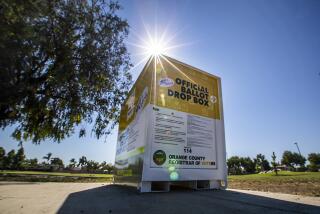Areas With Large Minority Numbers Exceed Census Goals
- Share via
WASHINGTON — Many Americans greeted the census this year with either a shrug of indifference or outrage over an intrusion into their privacy.
But an analysis of the latest tabulations released Tuesday shows that California communities with large minority populations are bucking the national trend.
Anaheim, Compton, Modesto and Santa Ana all have surpassed the performance targets set by the census for getting people to mail back census forms.
A minority undercount in the 1990 tally cost California more than $2 billion in federal funds during the decade and may have prevented the state from adding another seat to its 52-member delegation in Congress. A determined effort to improve the count this time--including high school rallies, parades and storefront posters in Spanish, Cambodian and Vietnamese--has promoted an unexpected wave of cooperation.
Nationally, the mail-in rate for the census has declined sharply since 1970, when 85% of households returned their forms. It slumped to 65% a decade ago. The Census Bureau’s ambitious goal this year was the 1990 rate plus 5 percentage points. So far, no state has met the 70% target. California has a response rate of 64%, compared with a national figure of 62%.
As for the cities, by Tuesday only 9% of them had met their targets. But in California--where 13% of the state’s 470 cities either met or exceeded their targets, the response was “very impressive,” said Tim Ransdell, executive director of the California Institute, a research organization that advises members of the state’s congressional delegation.
One of the key selling points for census officials, as well as politicians who have plied their constituents with information, was to convince wary immigrants that census data was confidential and would not be shared with any other federal agency. In fact, the census publishes reports with aggregate data gathered from its surveys and does not make reports on individuals available for 72 years.
Political leaders were jubilant at the news of California’s response.
Rep. Juanita Millender-McDonald (D-Carson), whose highly diverse district includes Compton, participated in high school rallies with “it’s cool to be counted” banners. She invited Census Director Kenneth Prewitt to the district to answer questions from residents who were worried about privacy and immigration issues. She also organized a campaign, in cooperation with ambassadors from African and Caribbean nations, to persuade immigrants from their countries to mail back census forms.
It was “successful far beyond any predictions,” she said.
Rep. Loretta Sanchez (D-Garden Grove) promoted the census at dozens of local events, including a Latino leadership breakfast, a black history parade, a Cambodian dance and a rally of Vietnamese high school and college students. “I’m thrilled that Santa Ana and Anaheim have exceeded expectations,” she said.
California contributed significantly to the drive for a better tally through its “complete count” program. Funded by a $24-million legislative appropriation, the program encouraged cooperation with the census.
Not surprisingly, state officials also hailed the outcome. “Terrific news for California,” said Maria Contreras-Sweet, secretary of the state’s Business, Transportation and Housing Agency.
The success of the mail-in effort is vital because it is the primary and the easiest way to gather the information about the American population. The mail-in campaign closed Tuesday and census officials will now prepare lists of those who failed to return the form. Enumerators hired by the census will go into the field later this month to try to persuade those who have not responded to fill out the forms.
The Census Bureau calculated that it had a national net undercount of 4 million people a decade ago, or 1.6% of the total population. But the undercount was 4.4% for blacks and 5% for Latinos. For California, it became particularly important to get an accurate count of minorities because they compose an increasing share of the population. It also is important because the census helps determine the dispersal nationally of $185 billion in federal funds each year.
Among the California localities matching or beating the census target were areas with large minority populations. Anaheim met its target of 69%, Modesto reached its goal of 70%, and Santa Ana--at 67%--bettered its target of 66%.
Compton fell below the state average, but still showed major gains, with a performance rate of 57%, higher than its goal of 54%. Other localities beating their targets included Baldwin Park, 69%; Bell Gardens, 67%; Calabasas, 72%; Chino Hills, 70%; Delano, 64%; East Palo Alto, 50%; El Monte, 68%; Inglewood, 59%; Irwindale, 69%; La Puente, 70%; and Laguna Hills, 70%.
None of the state’s biggest cities reached the Census Bureau’s goal for the mail-in program. The response rates for the major cities: Los Angeles, 58%; Long Beach, 63%; Fresno, 62%; Oakland, 56%; Riverside, 67%; Sacramento, 50%; San Bernardino, 56%; San Diego, 67%; San Francisco, 60%; and San Jose, 66%.
More to Read
Get the L.A. Times Politics newsletter
Deeply reported insights into legislation, politics and policy from Sacramento, Washington and beyond. In your inbox twice per week.
You may occasionally receive promotional content from the Los Angeles Times.










